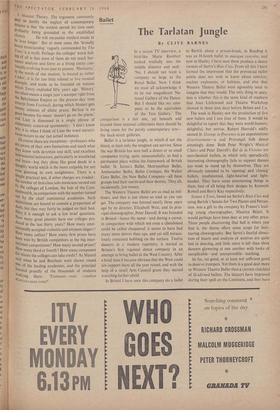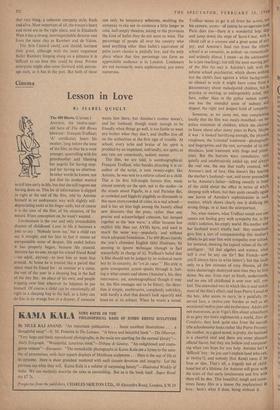Ballet
The Tarlatan Jungle
By CLIVE BARNES Ballet is a tarlatan jungle, in which if not the fittest, at least only the toughest can survive. Since the war Britain has seen half a dozen or so small companies trying, quite unsuccessfully, to find a permanent place within the framework of British ballet. St. James's Ballet, Metropolitan Ballet, Ambassador Ballet, Ballet Comique, the Walter Gore Ballet, the New Ballet Company—all these groups had their merits and their destiny. They all, incidentally, lost money.
The Western Theatre Ballet are as mad as mil- Iiners, and that is just about as mad as you can get. The company was formed nearly three years ago by its director, Elizabeth West, and its prin- cipal choreographer, Peter Darrell. It was founded in Bristol—hence the name—and during a career, in comparison with which not even a chessboard could be called chequered, it seems to have had many more downs than ups, and yet still miracu- lously remained bobbing on the surface. Twelve dancers in a modern repertory, it started as Britain's first regional dance company in an attempt to bring ballet to the West Country. After brief time it became obvious that the West could not support them all the year round, and with the help of a small Arts Council grant they started travelling farther afield.
In Bristol I have seen this company do a ballet
to BartOk about a prison-break, in Reading it was an H-bomb ballet to tnusique concrete, and now in Hanley I have seen them produce a dance version of Sartre's Huis Clos. From all this I have formed the impression that the provincial ballet public does no' wish to know about convicts, nuclear explosions, or lesbians, and also that Western Theatre Ballet were agreeably mad to imagine that they would. The only thing in ques- tion is whether this is the same kind of madness that Joan Littlewood and Theatre Workshop showed in those lean days before Behan and Co.
The week in Hanley saw the production of five new ballets and I saw four of them. It would be delightful to report that they were world-beaters; delightful, but untrue. Robert Harrold's oddly named St. George in Provence is an unpretentious diverti.ssement—a cod Provencal folk dance amusingly done. Both Peter Wright's Musical Chairs and Peter Darrell's Bal de la Victoire are neo-classical ballets, in which only sporadically interesting choreography fails to support themes too weak to stand up by themselves. They are obviously intended to be 'opening' and 'closing' ballets, insubstantial, light-hearted and light- headed. They have some entertaining things in them, best of all being their designs by Kenneth Rowell and Barry Kay respectively.
&mate a Trois, based on Sartre's Huis Clos and using Bartok's Sonata for Two Pianos and Percus- sion, was a gift to the company by France's lead- ing young choreographer, Maurice Mart. It would perhaps have been dear at any other price.
Three people discovering that hell is where you find it, the theme offers some scope for hair- tearing choreography. But Sartre's fearful dissec- tion of hearts and analysis of motives are quite lost in dancing, and little more is left than three dancers glowering at one another with looks of inexplicable—and unexpressible—loathing.
So far, no good, or at least not sufficient good to deserve trumpets, Yet there is a good deal more to Western Theatre Ballet than- a current clutchful of ill-advised ballets. The dancers have improved during their spell on the Continent, and they have
that rare thing, a coherent company style, fresh and alive. Most important of all, the troupe's heart and mind are in the right place, and in Elizabeth West it has a strong, inextinguishable director cast from the same clay as Rambert and de Valois.
The Arts Council could, and should, increase their grant, although with the more important Ballet Rambert limping along on a pittance it is -difficult to see how this could be done. Private enterprise might also come forward with patron- age cash, as it has in the past. But both of these can only be temporary solutions, enabling the company to eke out its existence a little longer in cold, half-empty theatres, taking to the provinces the kind of ballet they do not seem to want. The percentage of people all over the country who need anything other than ballet's equivalent of palm court classics is pitifully low, and the only place where that tiny percentage can form an appreciable audience is in London. Londoners are not necessarily more sophisticated, just more numerous.



































 Previous page
Previous page